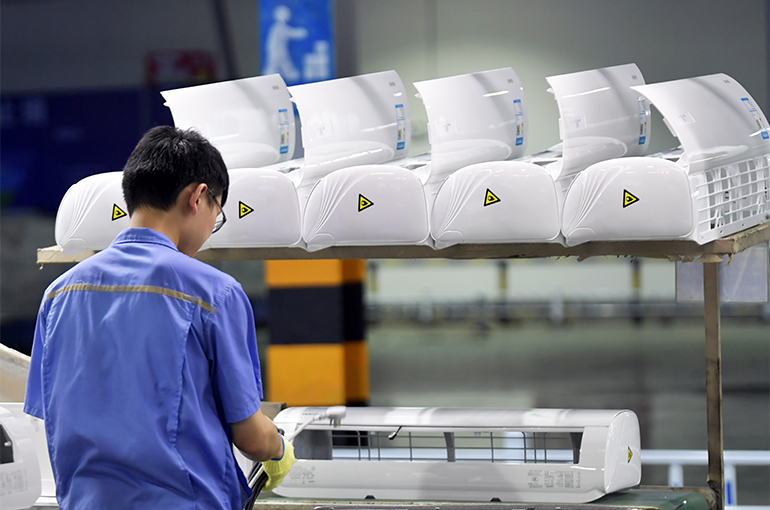 Chinese Air Con Firms Focus on Branding, Low-Tariff Plants in SE Asia to Hike Exports
Chinese Air Con Firms Focus on Branding, Low-Tariff Plants in SE Asia to Hike Exports(Yicai) March 26 -- Chinese makers of air conditioning equipment are increasing their emphasis on branding and accelerating the shift of production to Southeast Asia to avert hiked tariffs to stick to their market shares amid sluggish domestic growth.
Chinese firms are building their brands abroad and managing product prices by moving factories to Thailand and Indonesia to avoid paying higher import duties for China-made products in key markets such as the United States, Yicai learned.
Record Low US Exports
China's total exports of air conditioners for households rose by 8 percent to 66.2 million last year from the year before, according to data from ChinaIOL.Com, a research institute that focuses on home appliances. However, the nation exported fewer than eight million units to North America, down 25 percent from 2022, due to high inventory levels, insufficient demand, and trade tensions.
In terms of value, Japan overtook the States as the largest market for Chinese AC units with a sum of nearly USD 1.2 billion but the US remained the biggest market in terms of volume.
The changes are linked to trade barriers. Before 2019, the tariff on China-made AC units exported to the US was around 2 percent whereas now it is about 25 percent.
Capacity Transfer
Thailand has become the world's second-largest manufacturing hub for AC equipment as the SE Asian nation's capacity increased to 20.8 million units last year from 13.1 million units in 2019.
Qingdao-based Haier entered SE Asia in 2002 and started from Thailand. Last July, the company's local factory marked a milestone of 10 million finished AC units. Products exported to the US make up more than half of the plant's capacity but some products are also sold locally, Yicai learned.
Rivaling Midea Group is also present in Thailand. Last October, the Foshan-headquartered company's local plant celebrated its product No. 10 million. The firm set up its largest overseas factory in Thailand, investing over CNY1 billion (USD140 million). Midea operated six production lines to make AC equipment in Thailand as of last year, selling its products in North America, members of the Association of Southeast Asian Nations, and the Middle East. It also runs a research and development center and an AC compressor factory in Thailand.
Localization is paramount in Midea's globalization strategy as research, production, and sales are all ideally positioned locally, Zhou Zhiwen, general sales manager of Midea's AC business abroad, told Yicai recently.
Other Chinese firms that have invested in such factories in Thailand in recent years include Hisense and Aux Group.
Besides Thailand, Chinese firms are zooming in on Indonesia. TCL started operating its plant in the island country in 2020 whereas Haier expanded its factory to include AC units while Midea is planning to establish such capacity with the first product ready by the second quarter.
"Considering tariffs and corporate development needs, Chinese air conditioning companies will further expand overseas in the future," industry analyst Long Fei told Yicai, adding that some of the key regions are SE Asia and the Middle East.
Despite the SE Asian production push, China is expected to remain the world's main production hub for AC units due to labor supply, stable industry chains, and consistent policy, according to Long. The global capacity may have tallied around 330 million units last year, and the mainland is likely to have accounted for more than four-fifths of the total whereas other parts of Asia got a share of 16 percent.
Efforts to Hike Market Share
Chinese companies are keen on sticking to their market shares in core regions such as the US despite disruptions in the global economic and trade environment.
Early this year, companies such as Gree Electric Appliances, Haier, Midea, and Hisense participated in a trade show for refrigeration in the US. "This is the largest number of exhibitors in recent years, with over 50,000 participants for the first time," according to an executive from one of the participants.
Midea's goal for the next three to five years is to capture a 10 percent market share for its AC units in North America, GSM Zhou said, adding that the firm started to focus more on building its own brand in 2018 due to changes in the trade environment after first entering the market as an original equipment manufacturer.
Others know the importance of branding too. Haier's unit acquired General Electric's home appliance business in 2016 and this year the Chinese firm might introduce a new line of portable air conditioners in the US. Meanwhile, Gree primarily sells self-branded heat pumps that can provide heating in cold environments in North America, according to a person in charge of the firm's overseas business.
As domestic growth is slowing, Chinese home appliance brands have increased their investments overseas, focusing on enhancing brand and product strength, while seeing much higher sales growth and gradually rising market shares abroad, said Cai Ling, director of market research company GfK’s home appliance business in China.
Smaller brands are forced to react. If some small and medium-sized enterprises continue to rely on traditional development paths, their competitiveness weakens, leading to increased pressures, per Cai.
Editor: Emmi Laine